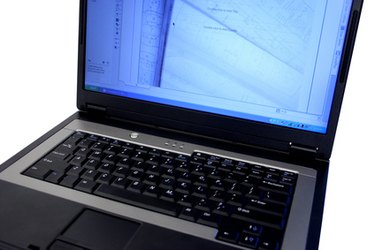
Headers and footers enable you to add consistent information to specific locations on your Microsoft PowerPoint slides. For example, you can display the date -- either a static value or one that always shows the current date when you open the presentation -- add slide numbers and include a copyright notice with your company name. When your slides include footers that you don't want to appear, you can track down the source of these special elements and prevent their inclusion.
'Apply to All'
Video of the Day
PowerPoint footers can display any text you type into the entry field for the feature. When you add headers and footers to Microsoft PowerPoint slides, the Header and Footer dialog box includes a button labeled "Apply to All." Once you activate the Footer check box and enter a message, the "Apply to All" button places that message on every slide in your presentation, even slides you add after you create your footer. Although you can delete these footers manually, it's easier to click on the "Insert" tab in the PowerPoint ribbon, locate the Text group, click on the "Header and Footer" item, uncheck the "Footer" option and click on the "Apply to All" button. Once you've dispensed with the global footers, you can go back to the Header and Footer settings and add a footer only to those slides on which you want one to appear, using the "Apply" button instead of "Apply to All."
Video of the Day
Header or Footer
If your slides contain an element you think is a footer, but turning off the footer option in the Header and Footer dialog box doesn't remove it from your slides, you may be trying to get rid of a header instead. Headers apply date-and-time information and add slide numbers, but they don't appear at the top of the slide, despite what their name may lead you to believe. Open the Header and Footer dialog box, and look for active check boxes associated with these slide elements.
Templates
Some PowerPoint templates include text or visual material at the bottom edge of the slide design. If you like the overall look of the template but don't want the bottom-edge elements on your slides, you can create a custom version of the template and remove or replace the items you don't want. Switch to the View tab, and in its Master Views group, click on "Slide Master" to view the slide layouts contained in the template that's currently applied to your PowerPoint file. You can customize the elements applied to any of the master layouts, removing items you don't want to appear in your presentation.
Background Image
Although you can add solids and gradients to slide backgrounds using the tools built in to PowerPoint, you also can construct these slide elements as image files in a bitmap-editing application. Slides that don't include headers and footers but still stubbornly include the kind of information you expect to find in a footer may use background images that include type rasterized into a JPG, PNG, TIFF or other bitmapped file. Switch to the Design tab, locate the Background group and click on "Hide Background Graphics." If the slide element vanishes, click on the "Background Styles" item and choose "Reset Slide Background" to delete the image.
- University of Pennsylvania Libraries: PowerPoint 2007 Tutorial: PowerPoint 2007 -- Notes, Headers, and Footers
- University of Pennsylvania Libraries: PowerPoint 2007 Tutorial: PowerPoint 2007 -- Slide Masters
- Microsoft Office: Add a Header or Footer
- Microsoft Office: Change or Delete Header and Footer Information in a Presentation
- Online Tech Tips: Add Headers and Footers to a PowerPoint Presentation
- Microsoft Office: Add Slide Numbers, Page Numbers, or the Date and Time
- Microsoft Office: Resize or Relocate Headers or Footers
- Microsoft Office: Insert a Background Picture, Color or Watermark to Your Slides
- Microsoft Office: Insert a Picture or Clip Art
- Microsoft Office: Create or Customize a Slide Master